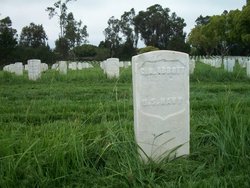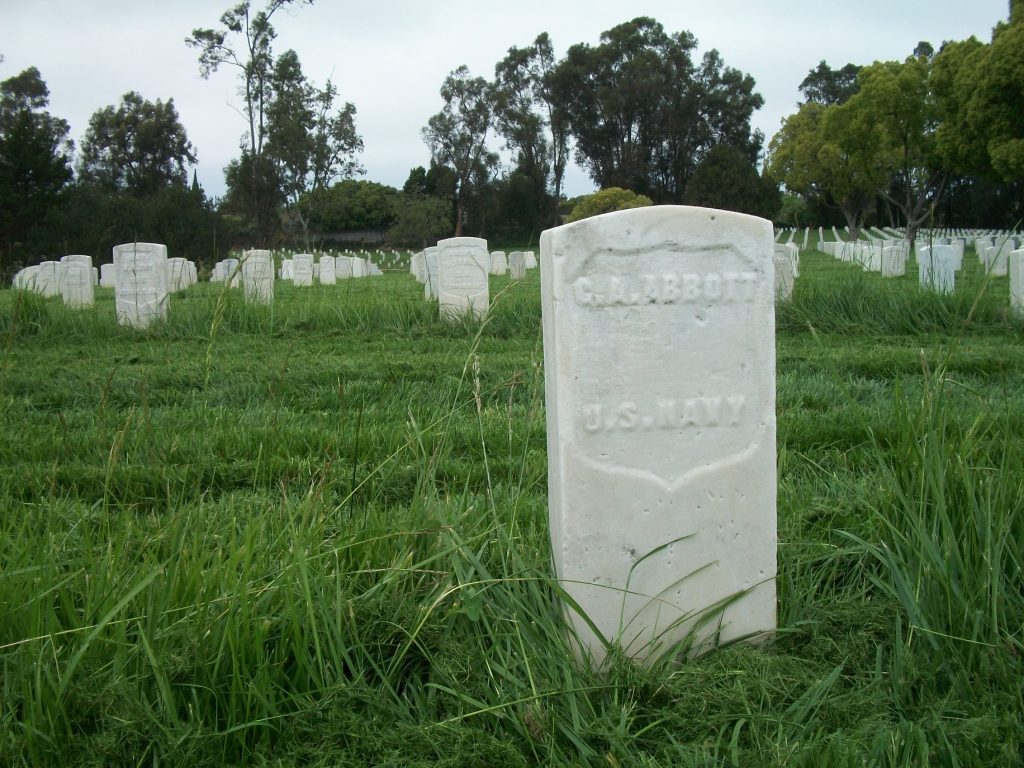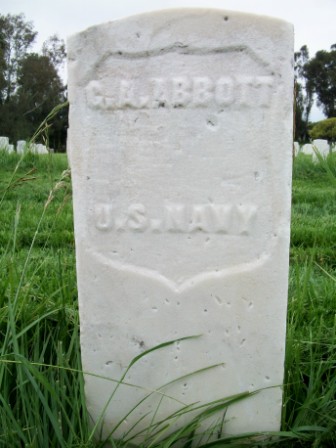Pension records show service on board USS Ohio as 1st Class Boy, USS Ironage, USS Release as 1st Class Boy, and USS Savannah as Landsman
U.S. Veterans Gravesites, ca.1775-2006about George A Abbott
Name: George A Abbott
Service Info.: US NAVY
Death Date: 19 Nov 1901
Cemetery: Los Angeles National Cemetery
Cemetery Address: 950 South Sepulveda Boulevard Los Angeles, CA 90049
Buried At: Section 6 Row F Site 3
Headstones Provided for Deceased Union Civil War Veterans, 1879-1903about Geo A Abbott
Name: Geo A Abbott
State of Cemetery: California
Date of Death: 19 Nov 1901
The second USS Ohio was a ship of the line of the United States Navy. She was designed by Henry Eckford, laid down at New York Navy Yard in 1817, and launched on 30 May 1820. She went into ordinary and in the ensuing years decayed badly. Refitted for service in 1838, Ohio sailed on 16 October 1838 to join the Mediterranean Squadron under Commodore Isaac Hull. Acting as flagship for two years, she protected commerce and suppressed the slave trade off the African coast. Ohio proved to have excellent performance under sail, repeatedly making more than 12 kn (14 mph; 22 km/h). One of her officers stated, "I never supposed such a ship could be built — a ship possessing in so great a degree all the qualifications of a perfect vessel." In 1840, Ohio returned to Boston where she again went into ordinary. From 1841-1846, Ohio served as receiving ship.
To meet the needs of the Mexican-American War, Ohio was recommissioned on 7 December 1846, and sailed on 4 January 1847 for the Gulf of Mexico, arriving off Veracruz on 22 March. Ohio landed 10 guns on 27 March to help in the siege of Veracruz; but the city soon surrendered.
Ohio drew too much water for coastal operations in the gulf. However, 336 of her crew participated in the Tuxpan River Expedition. In 1847, the entire distance from the mouth of the river to the town was covered with thick jungle growth. The enemy had constructed three well-positioned forts on bluffs overlooking bends in the river. On 18 April, Commodore. Matthew Perry arrived off the mouth of the river with 15 vessels. At 22:00, light-draft steamers Scourge, Spitfire, and Vixen, each towing a schooner, moved up stream. Bombships Etna, Hecla, and Vesuvius followed closely while 30 surf boats containing 1,500 men brought up the rear. Approaching the town, the squadron came under hot fire from Fort LaPena. Cmdre. Perry ordered Commander Franklin Buchanan to disembark the surf boats and storm the fort. As the landing party swept ashore, the Mexicans abandoned their position. The other two forts fell in a like manner, with only light casualties substained by the squadron. Men from Ohio retrieved the guns of brig Truxtun which had foundered in a storm near Tuxpan on 16 September 1846. The town was occupied and all military stores destroyed.
USS Iron Age (1862) was a steamer acquired by the Union Navy during the American Civil War. She was used by the Navy to patrol navigable waterways of the Confederacy to prevent the South from trading with other countries.
Iron Age was built at Kennebunk, Maine, in 1862; then purchased by the Navy at Boston, Massachusetts, 28 April 1863 and commissioned 25 June 1863, Lt. Comdr. E. E. Stone in command.
USS Release was a bark-rigged sailing vessel in the United States Navy during the American Civil War.
Release, formerly Eringol, was purchased 3 April 1855 at Boston, Massachusetts, and commissioned on that date for use as a storeship. In June 1855, she sailed as part of an Arctic expedition to search for Dr. Elisha Kane and his missing party of explorers. Release sailed November 1856 to Demerara, British Guiana, to pick up sugar cane cuttings for the Department of the Interior. In 1857, she carried supplies to Aspinwall (now Colón), Panama for the Pacific Squadron; in 1859 she carried stores to the Mediterranean Squadron. Later in 1859 she served as supply ship for the Paraguay expedition sent to Asunción to demand indemnity and apology from the Paraguayan Government for the firing on Water Witch in 1858.
On 5 April 1861, Release sailed to Fort Pickens, Pensacola, Florida, to act as supply ship for the Gulf Blockading Squadron. After returning to New York for more stores, she sailed for Hampton Roads, for similar duty with Atlantic Blockading Squadron. She was sent to Gibraltar on 30 September 1862 to meet Kearsarge and then directed to Algeciras, Morocco to watch the Confederate raider Sumter. During this period, Release unknowingly passed within 20 miles of another raider, Alabama.
From August 1863 to the end of hostilities, Release served as an ordnance storeship, based at Beaufort, North Carolina, for ships blockading the southern coast from Wilmington, North Carolina, to Norfolk, Virginia, either at sea delivering stores to the blockaders at their stations or at Beaufort tied up as a stores hulk.
Release was placed out of commission 6 October 1865 at Port Royal, South Carolina, and sold at public auction at New York 25 October 1865.
The second USS Savannah was a frigate in the United States Navy. She was named after the city of Savannah, Georgia.
Savannah was begun in 1820 at the New York Navy Yard, but she remained on the stocks until 5 May 1842, when she was launched. She was one of nine frigates to be built from a prototype design by naval architect William Doughty.
Savannah, with Captain Andrew Fitzhugh in command, joined the Pacific Squadron as flagship in 1844. As the prospect of war with Mexico became imminent, the Squadron moved into position off the California coast. On 7 July 1846, the Squadron captured Monterey without firing a shot. On 8 September 1847, Savannah returned to New York for repairs.
She served as flagship for the Pacific Squadron again from 1849-52. Repairs at Norfolk, Virginia took her into 1853, and on 9 August of that year, she sailed for a three-year cruise on the Brazil Station. In November 1856, she was inactivated, but served as flagship for the Home Squadron on the east coast of Mexico during 1859 and 1860.
USS Savannah, USS Saratoga and two charted steamers fought the small Battle of Anton Lizardo in 1860. Two armed Mexican vessels were captured by the Americans after they were deemed pirates by the Mexican government.
With the outbreak of the American Civil War in 1861, Savannah was deployed off the coast of Georgia, where she shared in the capture of two Confederate prizes, the schooner, E. J. Waterman, and the ship, Cheshire. On 11 February 1862, Savannah was taken out of active service and placed in use as an instruction and practice ship at the United States Naval Academy.
In 1870, after conducting her last training cruise to England and France, she was laid up at the Norfolk Navy Yard. She remained there until sold to E. Stannard and Company of Westbrook, Connecticut, in 1883.
Please send any additional information you may have on this man. USE EDIT ....
Pension records show service on board USS Ohio as 1st Class Boy, USS Ironage, USS Release as 1st Class Boy, and USS Savannah as Landsman
U.S. Veterans Gravesites, ca.1775-2006about George A Abbott
Name: George A Abbott
Service Info.: US NAVY
Death Date: 19 Nov 1901
Cemetery: Los Angeles National Cemetery
Cemetery Address: 950 South Sepulveda Boulevard Los Angeles, CA 90049
Buried At: Section 6 Row F Site 3
Headstones Provided for Deceased Union Civil War Veterans, 1879-1903about Geo A Abbott
Name: Geo A Abbott
State of Cemetery: California
Date of Death: 19 Nov 1901
The second USS Ohio was a ship of the line of the United States Navy. She was designed by Henry Eckford, laid down at New York Navy Yard in 1817, and launched on 30 May 1820. She went into ordinary and in the ensuing years decayed badly. Refitted for service in 1838, Ohio sailed on 16 October 1838 to join the Mediterranean Squadron under Commodore Isaac Hull. Acting as flagship for two years, she protected commerce and suppressed the slave trade off the African coast. Ohio proved to have excellent performance under sail, repeatedly making more than 12 kn (14 mph; 22 km/h). One of her officers stated, "I never supposed such a ship could be built — a ship possessing in so great a degree all the qualifications of a perfect vessel." In 1840, Ohio returned to Boston where she again went into ordinary. From 1841-1846, Ohio served as receiving ship.
To meet the needs of the Mexican-American War, Ohio was recommissioned on 7 December 1846, and sailed on 4 January 1847 for the Gulf of Mexico, arriving off Veracruz on 22 March. Ohio landed 10 guns on 27 March to help in the siege of Veracruz; but the city soon surrendered.
Ohio drew too much water for coastal operations in the gulf. However, 336 of her crew participated in the Tuxpan River Expedition. In 1847, the entire distance from the mouth of the river to the town was covered with thick jungle growth. The enemy had constructed three well-positioned forts on bluffs overlooking bends in the river. On 18 April, Commodore. Matthew Perry arrived off the mouth of the river with 15 vessels. At 22:00, light-draft steamers Scourge, Spitfire, and Vixen, each towing a schooner, moved up stream. Bombships Etna, Hecla, and Vesuvius followed closely while 30 surf boats containing 1,500 men brought up the rear. Approaching the town, the squadron came under hot fire from Fort LaPena. Cmdre. Perry ordered Commander Franklin Buchanan to disembark the surf boats and storm the fort. As the landing party swept ashore, the Mexicans abandoned their position. The other two forts fell in a like manner, with only light casualties substained by the squadron. Men from Ohio retrieved the guns of brig Truxtun which had foundered in a storm near Tuxpan on 16 September 1846. The town was occupied and all military stores destroyed.
USS Iron Age (1862) was a steamer acquired by the Union Navy during the American Civil War. She was used by the Navy to patrol navigable waterways of the Confederacy to prevent the South from trading with other countries.
Iron Age was built at Kennebunk, Maine, in 1862; then purchased by the Navy at Boston, Massachusetts, 28 April 1863 and commissioned 25 June 1863, Lt. Comdr. E. E. Stone in command.
USS Release was a bark-rigged sailing vessel in the United States Navy during the American Civil War.
Release, formerly Eringol, was purchased 3 April 1855 at Boston, Massachusetts, and commissioned on that date for use as a storeship. In June 1855, she sailed as part of an Arctic expedition to search for Dr. Elisha Kane and his missing party of explorers. Release sailed November 1856 to Demerara, British Guiana, to pick up sugar cane cuttings for the Department of the Interior. In 1857, she carried supplies to Aspinwall (now Colón), Panama for the Pacific Squadron; in 1859 she carried stores to the Mediterranean Squadron. Later in 1859 she served as supply ship for the Paraguay expedition sent to Asunción to demand indemnity and apology from the Paraguayan Government for the firing on Water Witch in 1858.
On 5 April 1861, Release sailed to Fort Pickens, Pensacola, Florida, to act as supply ship for the Gulf Blockading Squadron. After returning to New York for more stores, she sailed for Hampton Roads, for similar duty with Atlantic Blockading Squadron. She was sent to Gibraltar on 30 September 1862 to meet Kearsarge and then directed to Algeciras, Morocco to watch the Confederate raider Sumter. During this period, Release unknowingly passed within 20 miles of another raider, Alabama.
From August 1863 to the end of hostilities, Release served as an ordnance storeship, based at Beaufort, North Carolina, for ships blockading the southern coast from Wilmington, North Carolina, to Norfolk, Virginia, either at sea delivering stores to the blockaders at their stations or at Beaufort tied up as a stores hulk.
Release was placed out of commission 6 October 1865 at Port Royal, South Carolina, and sold at public auction at New York 25 October 1865.
The second USS Savannah was a frigate in the United States Navy. She was named after the city of Savannah, Georgia.
Savannah was begun in 1820 at the New York Navy Yard, but she remained on the stocks until 5 May 1842, when she was launched. She was one of nine frigates to be built from a prototype design by naval architect William Doughty.
Savannah, with Captain Andrew Fitzhugh in command, joined the Pacific Squadron as flagship in 1844. As the prospect of war with Mexico became imminent, the Squadron moved into position off the California coast. On 7 July 1846, the Squadron captured Monterey without firing a shot. On 8 September 1847, Savannah returned to New York for repairs.
She served as flagship for the Pacific Squadron again from 1849-52. Repairs at Norfolk, Virginia took her into 1853, and on 9 August of that year, she sailed for a three-year cruise on the Brazil Station. In November 1856, she was inactivated, but served as flagship for the Home Squadron on the east coast of Mexico during 1859 and 1860.
USS Savannah, USS Saratoga and two charted steamers fought the small Battle of Anton Lizardo in 1860. Two armed Mexican vessels were captured by the Americans after they were deemed pirates by the Mexican government.
With the outbreak of the American Civil War in 1861, Savannah was deployed off the coast of Georgia, where she shared in the capture of two Confederate prizes, the schooner, E. J. Waterman, and the ship, Cheshire. On 11 February 1862, Savannah was taken out of active service and placed in use as an instruction and practice ship at the United States Naval Academy.
In 1870, after conducting her last training cruise to England and France, she was laid up at the Norfolk Navy Yard. She remained there until sold to E. Stannard and Company of Westbrook, Connecticut, in 1883.
Please send any additional information you may have on this man. USE EDIT ....
Inscription
US Navy
Family Members
Sponsored by Ancestry
Advertisement
Advertisement











